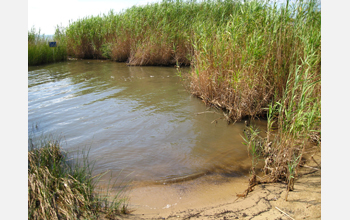Multimedia Gallery
Studying Effects of Deepwater Horizon Oil Spill (Image 1)
The beach at Bayfront Park, Ala., following a summer of heavy oiling and cleanup efforts from the Deepwater Horizon oil spill that took place in 2010. A team of researchers from the University of California, Davis, collected samples here to study the effects of the Deepwater Horizon oil spill on microbial eukaryote species. [Image 1 of 4 related images. See Image 2.]
More About This Image
Microbial eukaryote species, which are largely invisible to the naked eye, include groups such as nematode worms, protists and fungi. These microscopic species are often overlooked during environmental disasters, but they play important ecological roles. They represent the base of the food chain in marine ecosystems, and are additionally responsible for recycling nutrients, such as carbon, in the environment.
This study investigated the effects of the 2010 Deepwater Horizon oil spill on communities of microscopic eukaryotes in the Gulf of Mexico. Little is known about the biodiversity of these species in marine ecosystems--how many species exist, how do they co-exist and interact, and what is the geographic distribution for species that are assumed to have a limited ability to move around? Even less is known about the response of microbial species to environmental disturbances such as oil spills. Are most species resilient to pollutants or do communities change drastically following environmental impacts?
In this study, millions of "DNA barcodes" were obtained from Gulf beaches in order to describe microbial eukaryote communities before and after shoreline oiling. Initial work focused on five beach locations around Mobile Bay and Dauphin Island, Ala. Beach sediment was sampled in May 2010, before oil impacted the shoreline (pre-spill samples), and again in September 2010, after the sites had been affected by oil slicks and undergone cleanup efforts during the course of the spill (post-spill samples). An additional post-spill study site was Grand Isle, La., which was undergoing heavy oiling at the time of sample collection.
The study results showed dramatic changes to microbial communities after the 2010 Gulf oil spill. Pre-spill samples showed a typical microscopic beach community dominated by nematode worms, but containing a mix of other species such as arthropods, polychaete worms, protists, algae and fungi. Post-spill sites, on the other hand, were almost exclusively dominated by a few species of fungi. Oil-induced environmental stress may have favored a common set of resilient, opportunistic fungal species that could thrive at post-spill sites: previous studies have suggested that some of the observed fungal species may have been able to use oil compounds as a food source in post-spill sediments.
The present study offers only a small snapshot of the biological impacts resulting from the Gulf oil spill. The ultimate cause of the changes in beach microbial communities is still uncertain: Are the community shifts a direct result of oil impacts (as suggested by the dominance of oil-associated fungal taxa), or a function of mechanical beach cleanup efforts (which may have physically damaged and killed fragile microbial species)? Or were they perhaps influenced by seasonal variation in species abundance (a topic that has not been extensively studied in the Gulf region)? Further research is currently trying to answer some of these questions.
This research is funded by a collaborative National Science Foundation Grant for Rapid Response Research (RAPID), awarded in August 2010 to the University of New Hampshire, the University of Texas, San Antonio, and Auburn University. (Date of Image: September 2010)
Credit: Dr. Holly Bik, University of California, Davis
Images and other media in the National Science Foundation Multimedia Gallery are available for use in print and electronic material by NSF employees, members of the media, university staff, teachers and the general public. All media in the gallery are intended for personal, educational and nonprofit/non-commercial use only.
Images credited to the National Science Foundation, a federal agency, are in the public domain. The images were created by employees of the United States Government as part of their official duties or prepared by contractors as "works for hire" for NSF. You may freely use NSF-credited images and, at your discretion, credit NSF with a "Courtesy: National Science Foundation" notation.
Additional information about general usage can be found in Conditions.
Also Available:
Download the high-resolution JPG version of the image. (1.7 MB)
Use your mouse to right-click (Mac users may need to Ctrl-click) the link above and choose the option that will save the file or target to your computer.

